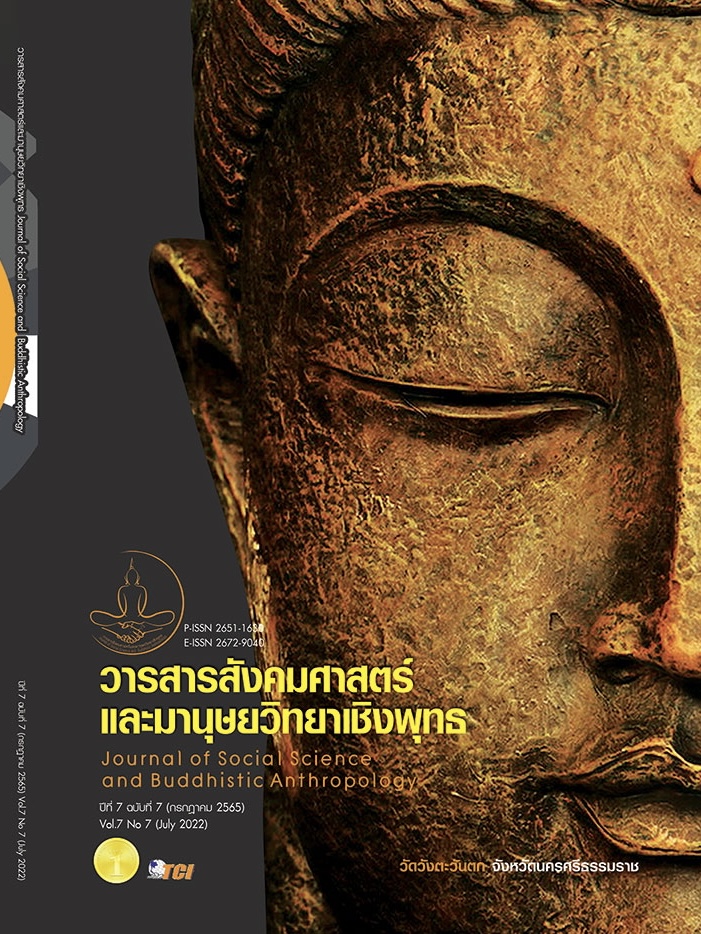CONSTRUCTION OF THE HEROIC KING ON THE WARRIOR CHARACTERISTIC OF AYUTTHAYA MONARCH IN THE WRITTEN PANEGYRIC VERSE OF KING
Keywords:
Construction, Warrior Heroism, Written Panegyric Verse of King, Ayutthaya MonarchAbstract
The objectives of this research article were to analyze the warrior characteristics of the Ayutthaya monarch and to analyze the construction of warrior heroism by considering the data from 5 Kings of the Ayutthaya period which appeared in the king praising literature, namely, King Boromatrailokanat in Lilit Yuanpai, King Naresuan the Great in Lilit Talengpai, King Prasat Thong in the praising of the late king Prasat Thong, King Narai the Great in the glorifying poem of King Narai the Great, and King Tai Sa in the poem Cha Lor Phra Phut Saiyat. The researcher analyzed the royal warrior characteristics from royal military activities and conducted the theory of warrior heroism construction with the cultural context. The results of the study were: 1) There were 3 characteristics of the royal warriors, namely, the royal warrior in the realm of war, the royal warrior in the realm of supporting the military, and the royal warrior in the realm of supporting Buddhism; 2) The construction of a heroic warrior king in a cultural context; four beliefs were found; Devaraja belief, diplomatic customs, performing the royal ceremony and Chakravartin belief. The foregoing beliefs aided in the formation of the 5 kings of the Ayutthaya period, each of whom had unique warrior traits but had the same goal of protecting the country from war in order to keep contentment and harmony in the Kingdom. The royal warrior characteristics were essential to the mental stability and tranquility of the country. The panegyric poems, in addition to recording historical events, were also empirical evidence of the relationship between the kings and the people through various royal duties for the benefit of all citizens.
References
กรมศิลปากร. (2540). ลิลิตยวนพ่าย ใน วรรณกรรมสมัยอยุธยา. เล่ม 1. กรุงเทพมหานคร: กรมศิลปากร.
ดำรงราชานุภาพ, สมเด็จพระเจ้าบรมวงศ์เธอ กรมพระยา. (2555). พระประวัติสมเด็จพระนเรศวรมหาราช. (พิมพ์ครั้งที่ 5). กรุงเทพมหานคร: มติชน.
บรมโกศ, พระเจ้า. (2545). โคลงชะลอพระพุทธไสยาสน์ ใน วรรณกรรมสมัยอยุธยา. เล่ม 3. กรุงเทพมหานคร: กรมศิลปากร.
บาหยัน อิ่มสำราญ. (2548). สมเด็จพระนเรศวรมหาราชจากวีรบุรุษของราชสำนักสู่วีรบุรุษแบบราชาชาตินิยม. เชียงใหม่: ภาควิชาภาษาไทย คณะมนุษยศาสตร์ มหาวิทยาลัยเชียงใหม่.
บุญเตือน ศรีวรพจน์. (2543). อธิบายเรื่องคำฉันท์สรรเสริญพระเกียรติสมเด็จพระพุทธเจ้าหลวงปราสาททอง ใน คำฉันท์สรรเสริญพระเกียรติสมเด็จพระพุทธเจ้าหลวงปราสาททอง. กรุงเทพมหานคร: กองวรรณกรรมและประวัติศาสตร์ กรมศิลปากร.
ปรมานุชิตชิโนรส, สมเด็จพระมหาสมณเจ้า กรมพระ. (2545). ลิลิตตะเลงพ่าย. (พิมพ์ครั้งที่ 4). กรุงเทพมหานคร: โรงพิมพ์คุรุสภาลาดพร้าว.
ปรีชา ช้างขวัญยืน. (2559). ธรรมรัฐ - ธรรมราชา. (พิมพ์ครั้งที่ 4). กรุงเทพมหานคร: โครงการตำรา คณะอักษรศาสตร์ จุฬาลงกรณ์มหาวิทยาลัย.
ปัทมา ฑีฆประเสริฐกุล. (2556). ยวนพ่ายโคลงดั้น : ความสำคัญที่มีต่อการสร้างขนบและพัฒนาการของวรรณคดีประเภทยอพระเกียรติของไทย. ใน ดุษฎีนิพนธ์อักษรศาสตรดุษฎีบัณฑิต สาขาวิชาภาษาไทย. จุฬาลงกรณ์มหาวิทยาลัย.
พระเทพเวที (ประยุทธ์ ปยุตฺโต). (2531). พจนานุกรมพุทธศาสน์ ฉบับประมวลศัพท์. (พิมพ์ครั้งที่ 4). กรุงเทพมหานคร: มหาจุฬาลงกรณ์ราชวิทยาลัย.
มโหสถ, หลวงศรี. (2540). โคลงเฉลิมพระเกียรติสมเด็จพระนารายณ์มหาราช ใน วรรณกรรมสมัยอยุธยา. เล่ม 1. กรุงเทพมหานคร: กรมศิลปากร.
ยุพร แสงทักษิณ. (2537). วรรณคดียอพระเกียรติ. กรุงเทพมหานคร: โรงพิมพ์คุรุสภาลาดพร้าว.
ราชครู, พระมหา. (2545). คำฉันท์สรรเสริญพระเกียรติสมเด็จพระพุทธเจ้าหลวงปราสาททอง ใน วรรณกรรมสมัยอยุธยา. เล่ม 3. กรุงเทพมหานคร: กรมศิลปากร.
เสาวณิต วิงวอน. (2530). การศึกษาวิเคราะห์วรรณกรรมยอพระเกียรติ. ใน ดุษฎีนิพนธ์อักษรศาสตรดุษฎีบัณฑิต สาขาวิชาภาษาไทย. จุฬาลงกรณ์มหาวิทยาลัย.
Downloads
Published
How to Cite
Issue
Section
License
Copyright (c) 2022 Journal of Social Science and Buddhistic Anthropology

This work is licensed under a Creative Commons Attribution-NonCommercial-NoDerivatives 4.0 International License.








